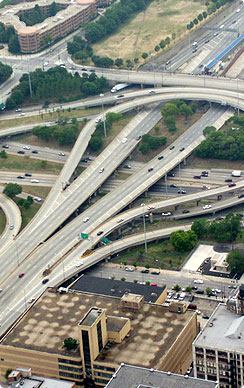History & Overview

The I-90/94 at I-290 Circle Interchange is located in the heart of downtown Chicago, adjacent to the west end of the central business district. Greektown is located to the northwest, and the University of Illinois at Chicago is situated to the southwest.
The Circle Interchange was built in the late 1950s and early 1960s, during the same time period as construction of the Kennedy Expressway. The Circle Interchange links to the Dan Ryan Expressway (I-90/94) to the south, the Kennedy Expressway to the north (I-90/94), the Eisenhower Expressway (I-290) to the west, and Congress Parkway to the east. Local traffic reporters commonly refer to this Interchange as the "Circle" since from above, the curving ramps appear to form concentric rings.
The Circle Interchange is critical to the nation's transportation system, particularly for freight movement on our Interstate and arterial roadways, as well as to regional railroads and waterways. The Circle Interchange serves as a vital hub for local, regional, and national freight traffic.
Truck traffic has grown and has a far more significant impact on roadway capacity, levels of service and traffic delays than the ±5% truck traffic that existed when the Interchange was originally designed.
According to the American Transportation Research Institute and the Federal Highway Administration, the Circle Interchange is the slowest and most congested highway freight bottleneck in the nation with more than 300,000 vehicles traveling through the Interchange on a daily basis, and over 1,100 crashes reported on average per year. Built more than 50 years ago, the Circle Interchange has not had a major rehabilitation since its initial construction. High traffic volumes, single lane ramps and tight curves make the Circle prone to congestion which causes it to operate under breakdown conditions for most of the day.
The Circle Interchange Project is a two-year planning and design project which will identify the scope of improvements and the potential cost and construction schedule. Currently, the planning (Phase I) and design (Phase II) phases are funded in the Department's 2013-2018 Multi-Year Highway Improvement Program. The construction phase (Phase III) remains unfunded at this time. However, as part of this first phase, financial strategies will be investigated.




